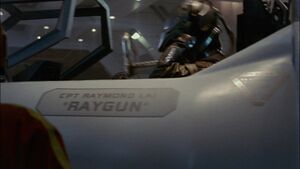| |||||

| |||||
| Portrays: | Pegasus sergeant | ||||
| Date of Birth: | March 2, 1972 | ||||
| Date of Death: | Missing required parameter 1=month! , | ||||
| Age: | 53 | ||||
| Nationality: | |||||
| Related Media | |||||
|---|---|---|---|---|---|
| @ BW Media | |||||
[{{{site}}} Official Site]
| |||||
Kimani Ray Smith (born March 2, 1972) is the actor who portrayed a Pegasus sergeant in "The Captain's Hand".
Born in Toledo, Ohio, Smith has acted in various other genre series, including Stargate Atlantis, Smallville and Dead Like Me.
| |||||

| |||||
| {{{credit}}} | |||||
| Portrays: | Vector | ||||
| Date of Birth: | January 10, 1904 | ||||
| Date of Death: | January 15, 1987 | ||||
| Age at Death: | 83 | ||||
| Nationality: | |||||
| Related Media | |||||
|---|---|---|---|---|---|
| @ BW Media | |||||
[{{{site}}} Official Site]
| |||||
Ray Bolger (born 10 January 1904 in Dorchester, Massachusetts, died 15 January 1987 in Los Angeles, California) was an American theatre, film and television actor.
Bolger was a Vaudevillian actor as one-half of a comedy duo. Like many actors of his era, Bolger's skills combined acting with song and dance skills.
He was signed on by MGM Studios in 1936 for a role as himself in the movie, The Great Ziefield. Various combination acting, singing and dancing roles followed, which culminated in what was to be his most memorable role as the Scarecrow in the classic film, The Wizard of Oz.
Bolger's contract with MGM ended shortly after, but the actor went on to the new world of television, starring in his own situation comedy, Where's Raymond? (later called The Ray Bolger Show) in 1953.
Bolger won a Tony Award, as well as two Donaldson Awards in 1948 for the musical Where's Charley?. In 1980, he was elected to the Theatre Hall of Fame.
Bolger appeared as a guest in many more television roles and a few film roles throughout the latter half of the 20th Century. In the documentary film, That's Dancing!, Bolger co-hosted the film with many other classic and contemporary dancing actors, including Oz co-star Judy Garland's daughter, Liza Minnelli.
Bolger portrayed Vector, the android on Paradeen in the Original Series episode "Greetings From Earth".
Bolger was the last surviving member of the four central characters of The Wizard of Oz. He died of cancer in 1987.
| |||||

| |||||
| {{{credit}}} | |||||
| Portrays: | Newspaper Boy | ||||
| Date of Birth: | February 2, 1942 | ||||
| Date of Death: | October 29, 2018 | ||||
| Age at Death: | 76 | ||||
| Related Media | |||||
|---|---|---|---|---|---|
| @ BW Media | |||||
[{{{site}}} Official Site]
| |||||
Ray Duke is the actor who portrayed a newspaper boy in "Galactica Discovers Earth," Part I & III, episodes of Galactica 1980.
He is the elder brother of Patty Duke and, consequently, the uncle of her sons Sean Astin and Mackenzie Astin.
| |||||

| |||||
| {{{credit}}} | |||||
| Portrays: | Sire Uri | ||||
| Date of Birth: | January 3, 1907 | ||||
| Date of Death: | March 10, 1986 | ||||
| Age at Death: | 79 | ||||
| Nationality: | |||||
| Related Media | |||||
|---|---|---|---|---|---|
| @ BW Media | |||||
[{{{site}}} Official Site]
| |||||
Ray Milland (born Alfred Reginald Jones) (January 3, 1907—March 10, 1986) was a Welsh actor and director of American film and television. His screen career ran from 1929 to 1985, and he is best remembered for his Academy Award-winning portrayal of an alcoholic writer in Billy Wilder's The Lost Weekend (1945). He was also the murder-plotting husband in Alfred Hitchcock's Dial M For Murder (1954) (with John Williams), and Oliver Barrett III in Love Story (1970)
He was born in Neath, Glamorgan, Wales and he died of lung cancer in Torrance, California.
Notes
edit- Milland is the only actor to have appeared on the original Battlestar Galactica who won an acting Academy Award during his or her career.
External Links
edit


